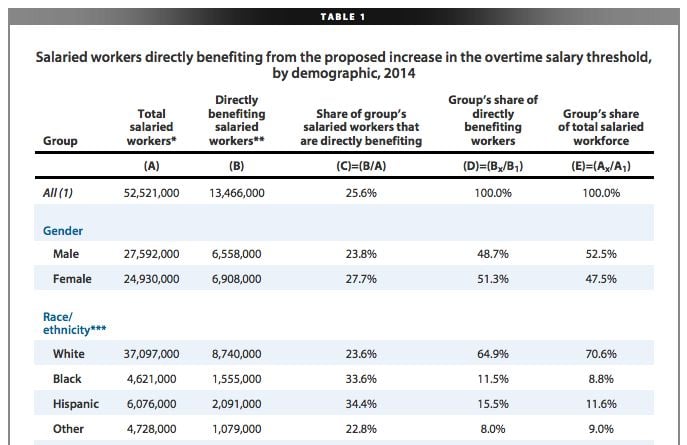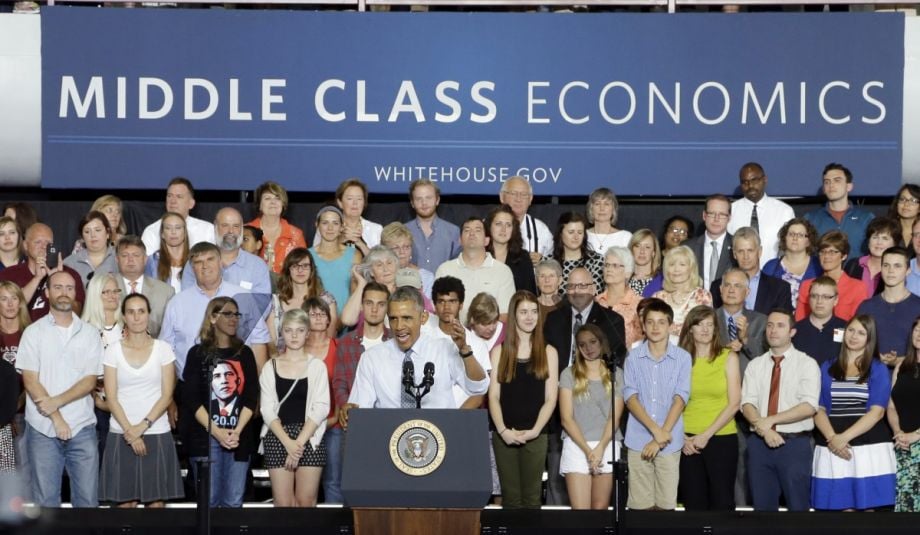“Living wage” advocates continue to build upon victories earned in city halls across the country, and 2016 presidential candidate Bernie Sanders recently called on President Obama to establish a national $15 minimum wage through an executive order. Though more than 20 minimum-wage increases have occurred in local jurisdictions in the last two years, federal action from this administration appears to be a long shot. Meanwhile, an alternative plan to aid the middle class — one endorsed by Obama and more likely to materialize — has received comparatively less attention and stands to increase take-home pay for millions of Americans by way of adjustments to the Fair Labor Standards Act of 1938.
At the end of June, the Department of Labor released an ambitious proposal to rewrite the FLSA rules governing who is eligible for overtime pay, a move that, according to the federal government, would result in newfound overtime eligibility for seven million Americans. Currently, salaried workers making more than $23,660 a year (for a family of four, that’s below the poverty line) can’t get overtime pay. That means a restaurant manager could be disqualified from overtime while qualifying for federal subsidies related to poverty.
Last week, the Economic Policy Institute, a left-leaning think tank, released its own study gauging the magnitude of the DOL proposal, which would lower the salary. It estimated that nearly double the amount of workers would benefit, and crucially, identified who they were.
Not only would the changes result in a broader impact than the government anticipated — 13.5 million workers would start receiving overtime as a result, the EPI found — but further, a large share of those positively affected would be minority groups. The study found that more than one in three salaried workers who are black, and more than one in three who are Hispanic currently have pay levels that fall between the old threshold and proposed new threshold of $50,440 a year. Combined, that would be 3.5 million people of color newly eligible for overtime.

(Credit: Economic Policy Institute)
If the projections are accurate, the DOL proposal would infuse the nation’s overtime rules with a renewed sense of equity or, as President Obama put it when he signed a Presidential Memorandum last spring calling for an update and simplification to the FLSA, make those workers “a linchpin of the middle class” once again.
Overall, in the government’s online forum asking for public comment on the changes, the most talked-about adjustment is creating a new threshold for who qualifies for automatic time-and-a-half pay. The White House notes that the cutoff has fallen further and further behind the pace of inflation in recent years: 65 percent of salaried workers qualified for overtime in 1975; only 12 percent do today.
In addition to moving the line to more than $50,000, the DOL would add a mechanism for raising the overtime threshold annually in perpetuity. The changes would ensure the bottom 40 percent of full-time salaried earners qualify for automatic overtime, instead of the bottom 10 percent as it currently stands.
In recent years, both higher wages and higher employment have been going to whites. A study commissioned by the City of Boston and released in April bears that out just in the municipal sector alone: According to the report, 74 percent of the city’s department heads are white, and “white employees throughout city government [are] earning a higher average salary.” The outsized impact of the DOL proposal offers a chance to start correcting this trend.
There are, of course, those who don’t agree with the notion that these changes will hasten any sort of broad economic improvements for the middle class, as the EPI projects. A study commissioned by the National Retail Federation concluded there would be negligible, if any, gains for workers, because employers would do everything in their power to rearrange work to skirt the new costs. The NRF study estimated 32 percent of workers in the retail and restaurant industries would be shifted to hourly wages, instead of salaries, resulting in higher overtime pay but lower base pay. Their income would essentially be a wash, while losing benefits.
The rule change does not require Congressional approval, although it’s expected to be challenged in Congress and by litigation from business groups. According to the New York Times, Republican lawmakers could “attach a so-called rider undoing the change to must-pass appropriations measures later this year.”
Economists with a rosier view of the FLSA adjustments call it like this: Either employers will be forced to raise wages through new overtime rules, or, hire new workers in order to avoid overtime payouts. In short, either wages will go up or unemployment will go down.
The Equity Factor is made possible with the support of the Surdna Foundation.

Malcolm was a Next City 2015 equitable cities fellow, and is a contributing writer for the Fuller Project for International Reporting, a nonprofit journalism outlet that reports on issues affecting women. He’s also a contributing writer to POLITICO magazine, Philadelphia magazine, WHYY and other publications. He reports primarily on criminal injustice, urban solution and politics from his home city of Philadelphia.

















